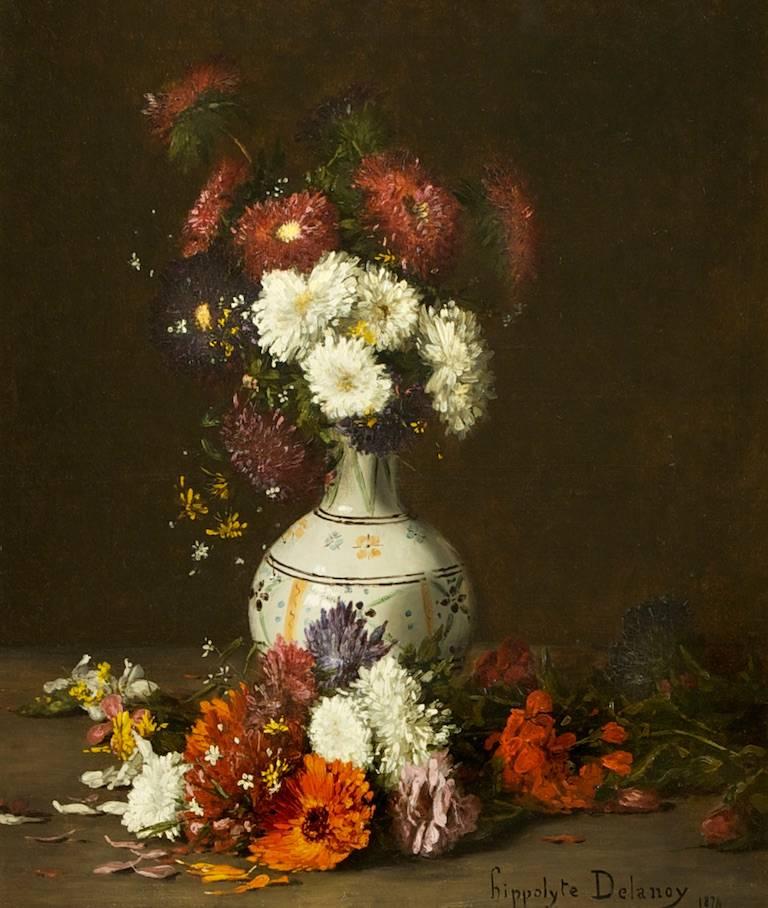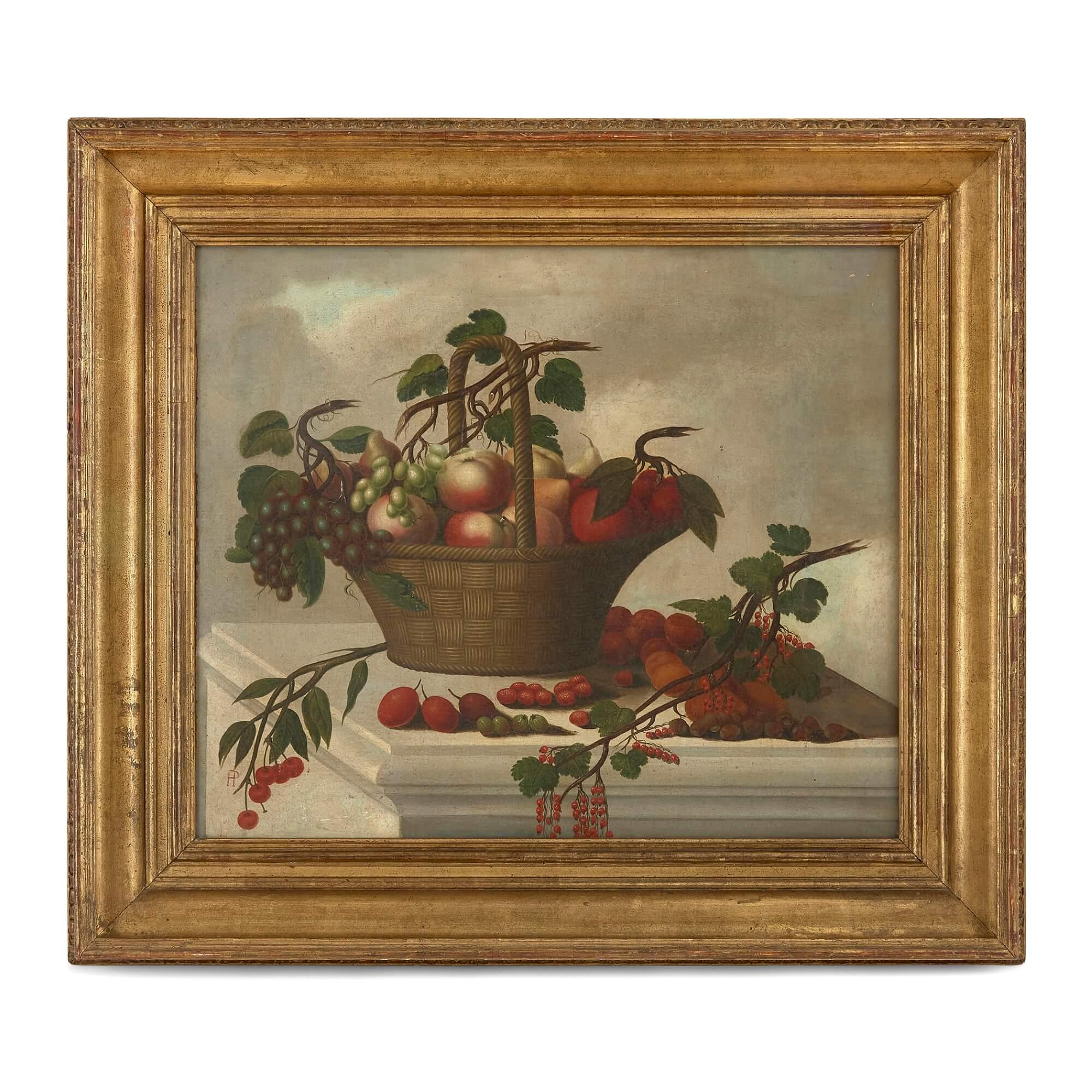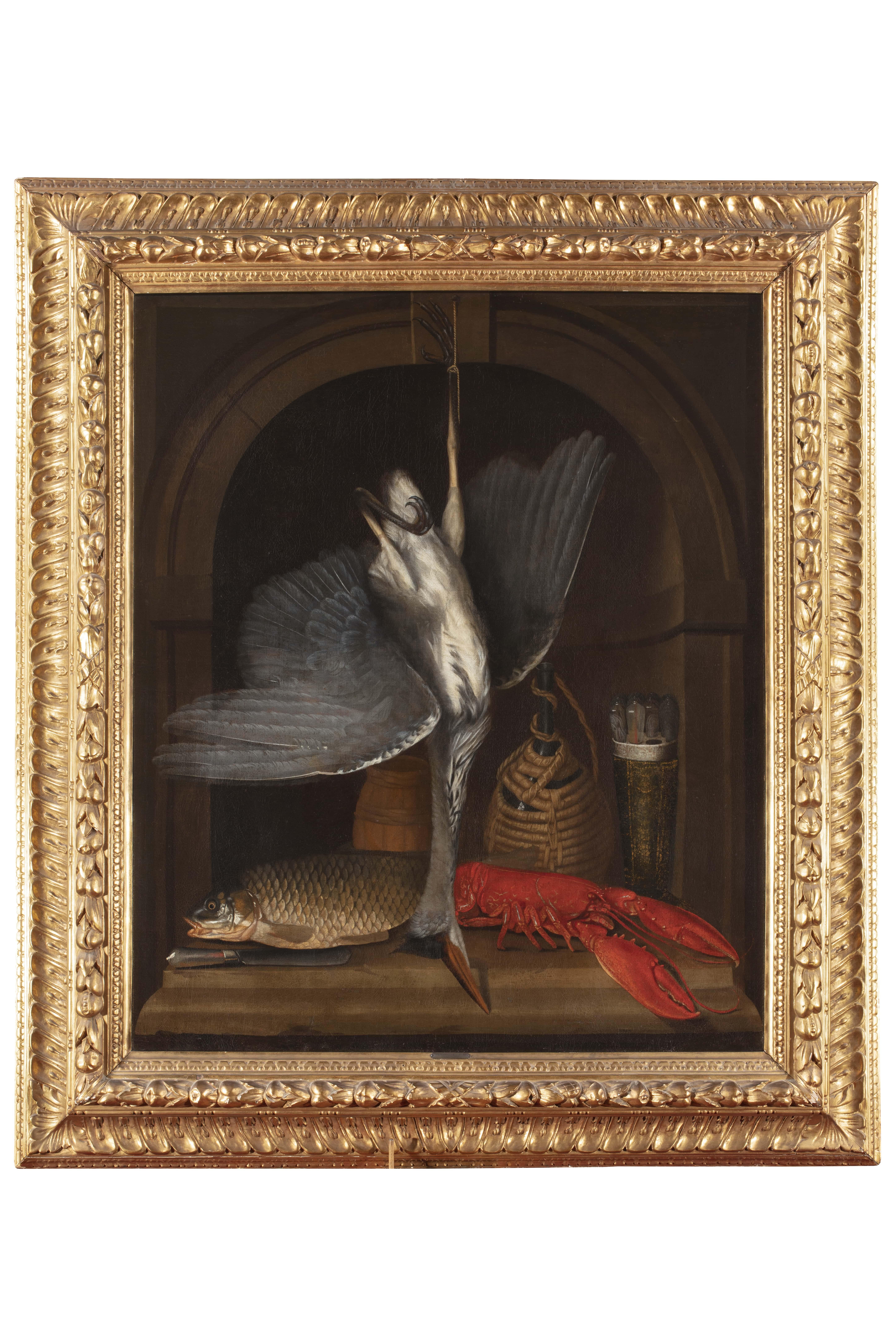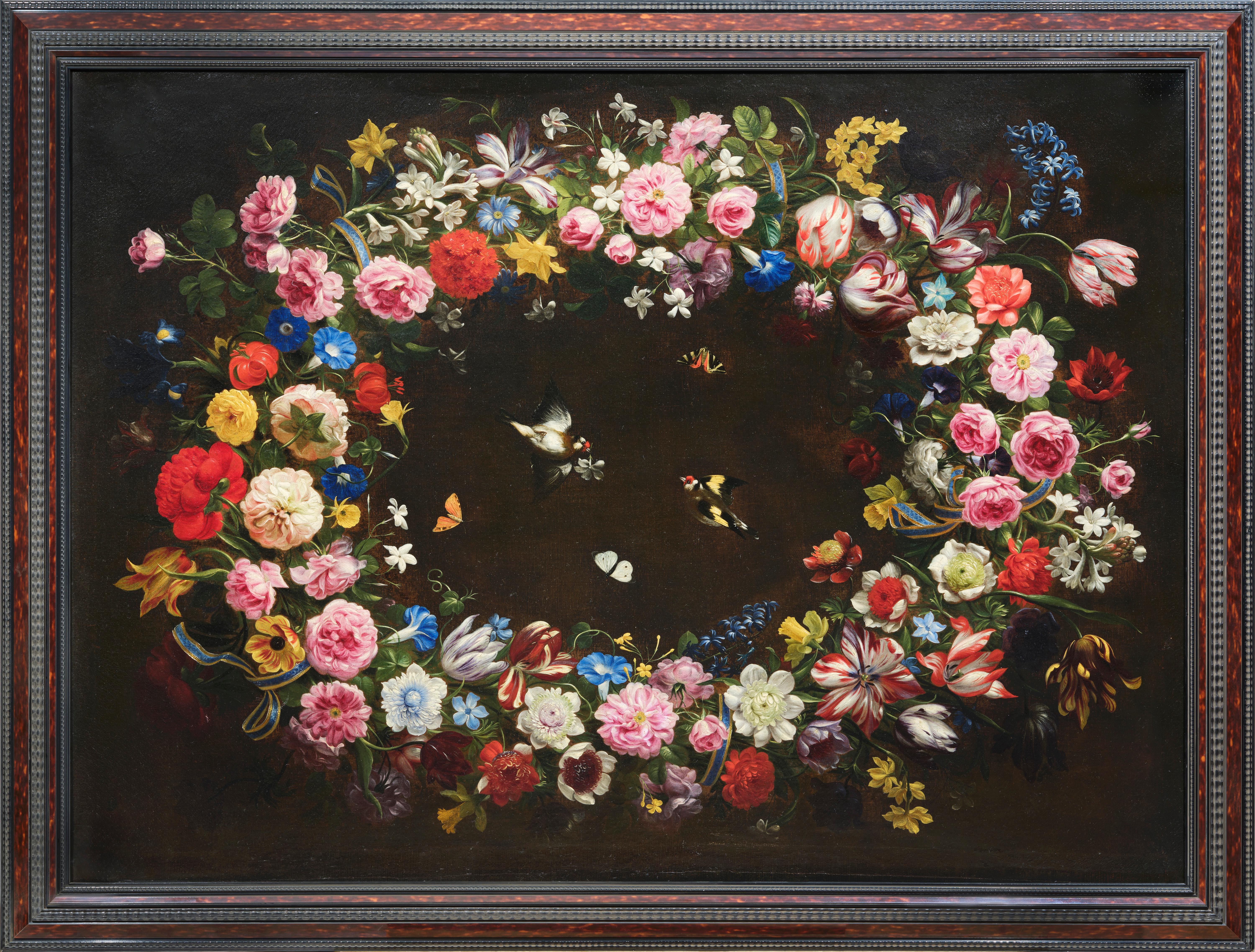Items Similar to Angels Flower Garzi Paint Oil on canvas Old master 17/18th Century Italian Art
Want more images or videos?
Request additional images or videos from the seller
1 of 22
Angels Flower Garzi Paint Oil on canvas Old master 17/18th Century Italian Art1680-1720
1680-1720
About the Item
Roman school of the early 18th century
Luigi Garzi (Pistoia 1638– Rome1721) attributed
Still life of fruit supported by three angels
Oil on oval canvas
116 x 91 cm., Framed 140 x 119 cm.
Authentication on a photograph by Prof Giancarlo Sestieri, who attributes the work to the sphere of Luigi Garzi
This magnificent canvas, depicting a sumptuous composition of fruit supported by three prosperous winged cherubs, from which comes a parchment bearing the Latin expression "Amor est vitae essentia", is to be placed in the production of a Roman author active between the second half of XVII century and the first of the following century.
The iconography that sees represented cherubs with fruit or flowers is frequent in the Baroque period, especially in the Roman area, starting from the 1600s, with that particular depictional tendency aimed at illusionistic and frivolous images, to a type of paintings or frescoes of strong value decorative, intended for the private context and depicting jubilation of cherubs, angels or cherubs, and of which our canvas represents a perfect example.
We can recall, among the most illustrious iconographic precedents, the elegant mirrors painted by Mario Nuzzi and Carlo Maratta that adorn the hall of Palazzo Colonna in Rome, and again the canvas preserved in the Rouen museum and the similar ones in Palazzo Chigi in Ariccia, with the collaboration for the figurative parts of Filippo Lauri.
The commercial and furnishing success of similar works is also testified by authors such as Guglielmo Cortese known as Borgognone (1628 - 1679), Franz Werner Von Tamm (1658 - 1724), Giovan Battista Gaulli (1639 - 1709), Giovanni Paolo Castelli known as Spadino (Rome 1650 - 1740) and the aforementioned Carlo Maratta (1625 - 1713)
The work, studied by Giancarlo Sestieri, was brought closer to the sphere of the eclectic Pistoian painter Luigi Garzi, one of the protagonists of Roman painting in the decades of transition between the seventeenth and eighteenth centuries. In our painting we can find the typical elements of his painting: the soft and delicately chiaroscuro light, the sculptural classicism of the figures as well as the stupendous luministic and chromatic effects.
Luigi Garzi's training and artistic activity took place in the Eternal City and he was in effect a Roman artist. He moved to Rome from Pistoia, his hometown at a very young age, and joined the atelier of Andrea Sacchi, who directed his studies towards classicism, comparing himself with the works of Raphael, Domenichino and Nicolas Poussin, but also with the Emilian one. , with particular attention to the school of Guido Reni.
But the Emilian examples were undoubtedly preceded, particularly by Giovani Lanfranco, who modeled his taste and style, together with a modulated cortonism, while those pre-eighteenth-century sensibilities are due to the lesson of Carlo Maratta.
However, there is no doubt that the painter oriented his personality without ever bowing to imitation, reaching a refined elegance and autonomy of language, as the canvas in question clearly demonstrates in which the different influences find a refined amalgamation in perfect harmony with the baroque evolution between the seventeenth and eighteenth centuries, indicating a dating to its earliest maturity.
These attitudes led the painter to obtain awards and prestigious commissions as soon as possible, such as the frescoes of Palazzo Borghese and San Carlo al Corso, where the memories of Domenichino and Reni emerge, up to the dome of the Cybo Chapel in Santa Maria del Popolo. Returning to the work, we can then assume a mature chronological position, due to the peculiar drafting, which is attested to by brushstrokes in enamelled shades and a heartfelt classicism.
The painting is in excellent condition, with a beautiful antique frame.
The work is accompanied by a certificate of photographic authenticity in accordance with the law.
We take care and organize the transport of the purchased works, both for Italy and abroad, through professional and insured carriers. For any additional information, please do not hesitate to contact us.
- Attributed to:Luigi Garzi (Pistoia 1638– Rome1721) (1638 - 1721, Italian)
- Creation Year:1680-1720
- Dimensions:Height: 55.12 in (140 cm)Width: 46.86 in (119 cm)
- Medium:
- Movement & Style:
- Period:Late 17th Century
- Condition:
- Gallery Location:Riva del Garda, IT
- Reference Number:1stDibs: LU98819352142
About the Seller
4.8
Platinum Seller
These expertly vetted sellers are 1stDibs' most experienced sellers and are rated highest by our customers.
Established in 2017
1stDibs seller since 2018
202 sales on 1stDibs
Typical response time: <1 hour
- ShippingRetrieving quote...Ships From: Riva del Garda, Italy
- Return PolicyA return for this item may be initiated within 7 days of delivery.
More From This SellerView All
- Still-life Flower Paint Oil on canvas Old master 17th Century Lombard schoolLocated in Riva del Garda, ITFrancesca Volò Smiller, called Vincenzina (Milan, 1657 - 1700) - circle of Floral composition Oil on canvas (97 x 72 cm. - in octagonal frame 100 x 84 cm.) A rich floral compositio...Category
17th Century Old Masters Paintings
MaterialsOil
- Flower Still-life Virgin Trevisani Stanchi Paint Oil on canvas 17/18th CenturyBy Francesco Trevisani (Capodistria 1656 - Rome 1746)Located in Riva del Garda, ITFlower garland with a portrait of the Virgin Francesco Trevisani (Capodistria 1656 - Rome 1746) and Niccolò Stanchi (Rome 1623 - 1690), attributable Oil on canvas 66 x 49 cm. - In f...Category
18th Century Old Masters Still-life Paintings
MaterialsOil
- Ascione Still Life Paint Oil on canvas Old master Baroque 17/18th Century ItalyBy Aniello Ascione (Naples, news from 1680 to 1708)Located in Riva del Garda, ITAniello Ascione (Naples, news from 1680 to 1708) Still life with festoon of flowers and fruit Oil painting on canvas, 89 x 117 cm in frame cm 109 x 137 With expertise and attributive study by Prof. Stefano Causa (University of Naples) '' This fruit composition with a festoon of flowers belongs to Aniello Ascione's brush and is a prominent addition to the final game of the Neapolitan still life - the most baroque and decorative one can imagine. The naturalistic work, still Caravaggesque, of the specialists of the early sixteenth century, from Luca Forte to Porpora, now seems a distant memory. The name of Ascione also comes from the comparison with the still life signed by the Civic Museum of Castello Ursini in Catania, against which the painting in question qualifies as a sixteenth version. On the other hand, it is not uncommon for easily repeatable patterns to recur in the workshops of still life painters. The melon on the right, the rush of flowers and, in the background, the profile of a column or a fountain. We could compare them to the normalized formal types used by great southern...Category
17th Century Old Masters Paintings
MaterialsOil
- Still-Life Flower Landscape Castelli Paint Oil on canvas Old master Italian artBy Giovanni Paolo Castelli, known as Spadino (Rome, 1659 - 1730)Located in Riva del Garda, ITStill life in a landscape with fruit and game Work of the late Roman Baroque of the late seventeenth / eaarly eighteenth century attributable to Giovanni Paolo Castelli, known as Spadino (Rome, 1659 - 1730) oil on canvas 62 x 76 cm., Framed 90 x 109 cm. An open-air setting, with a hilly landscape gash that opens into the distance in the central part, surrounds our beautiful canvas, which showcases a rich selection of game and fruit, arranged in the foreground near the point of view of the observer, occupying a large part of the visual field with their bright and festive colors. The style and quality of the work, like the pictorial technique of this still life, characterized by subtle luminous vibrations and a lively chroma, make it attributable to the Roman Giovanni Paolo Castelli, known as Lo Spadino (Rome, 1659 - 1730), one of the most important specialists of this pictorial genre of late Baroque Rome, which had a very successful career between the 17th and 18th centuries. Analyzing the rich and heterogeneous catalog of the Roman master, in fact, our canvas can be included among his rare works which, alongside a selection of fruit - among which stand out large melons, ripe figs, dark grapes and plums - we see a game advert, presumably as requested by a patron who loves hunting. Next to various birds, spoils of a profitable hunting trip, there is also a small green woodpecker, with the characteristic red spot on the head, and a nice rodent that terminates from behind the trunk. The painter abandons himself to a skilful and brilliant chromatic texture of the surfaces, through a pictorial material rendered with exceptional vibration in its luminous and 'tactile' body, fully respecting the taste of the full Roman Baroque. The quality appears excellent, distinguished by a skilful and brilliant chromatic texture of the surfaces, which appear almost vibrant thanks to a skilful drafting of the pictorial material. Inevitable and evident are the Flemish suggestions, which had influenced the Roman Baroque still life, in particular the work of Abraham Brueghel...Category
Late 17th Century Old Masters Paintings
MaterialsOil
- Pieter Casteels III 'Signed' Floral Still Life Old master Paint 18th Century ArtBy Pieter Casteels III (Antwerp 1684 - 1749 Richmond)Located in Riva del Garda, ITPieter Casteels III (Antwerp 1684 - 1749 Richmond) circle Floral still life Signed lower left, on the stone: P Casteels About 1730 Oil painting on...Category
18th Century Old Masters Paintings
MaterialsOil
- Still Life Vanitas Noletti Paint Oil on canvas Old master 17th Century ItalianLocated in Riva del Garda, ITFrancesco Noletti known as the Maltese (Malta 1611-Rome 1654) Workshop/circle of Still life with musical instruments, toys, armour, textiles and precious objects Oil on canvas (52 x...Category
17th Century Old Masters Paintings
MaterialsOil
You May Also Like
- Still Life of Flowers in a Vase late Victorian 19th Century Hippolyte DelanoyBy Hippolyte Pierre DelanoyLocated in Lincoln, GBHippolyte Pierre Delanoy (1849-1899) A Study of Flowers 1874 Signed and Dated, Oil on Canvas, 57 x 49cm Delanoy was born in Glasgow, of French Parents and was the brother of painter...Category
Late 19th Century Old Masters Still-life Paintings
MaterialsOil
- Still life painting of fruit in a basketLocated in London, GBStill life painting of fruit in a basket Continental, c. 1800 Frame: Height 81cm, width 91cm, depth 7cm Canvas: Height 57cm, width 69cm, ...Category
Late 18th Century Old Masters Still-life Paintings
MaterialsCanvas, Oil
- 17th century By Dutch maestro Still life with bird, carp & lobster Oil on canvasLocated in Milano, LombardiaThis painting fits well into the Dutch pictorial production of the Golden century. The composition, built on the harmonious presentation of rich wild game and fine details such as th...Category
17th Century Old Masters Still-life Paintings
MaterialsCanvas, Oil
- Classical Still Life of Flowers Ornate Display Antique Dutch Oil PaintingLocated in Cirencester, GloucestershireProfusion of Flowers Classical Still Life Dutch School, 19th century oil on canvas, unframed canvas : 32 x 21 inches provenance: private collection condition: very good and sound con...Category
Late 19th Century Old Masters Still-life Paintings
MaterialsCanvas, Oil
- Antique French Still Life of Flowers in Vase Signed Oil Painting on CanvasLocated in Cirencester, GloucestershireClassical Still Life of Flowers in a Vase French School, circa 1900 signed oil on canvas, unframed canvas: 22 x 18 inches provenance: private collection, France condition: very good ...Category
Early 20th Century Old Masters Still-life Paintings
MaterialsOil
- Flower Garland by Giovanni Stanchi, the most Flemish Italian flower painterBy Giovanni StanchiLocated in PARIS, FRThis painting is reproduced in the reference book on Roman still life "Pittori di nature morta a Roma - artisti italiani 1630 -1750" by Gianluca and Ulisse Bocchi - Arti Grafiche Cas...Category
17th Century Old Masters Still-life Paintings
MaterialsCanvas, Oil
Recently Viewed
View AllMore Ways To Browse
Antique Italian Art
Antique Flower Art
Old Flower
Canvas Painted Flowers
Old Italian Artist
Old Masters Study
18th Century Italian Art
17 Century Painting
Flowers Art Composition
Art For Law
Italian Baroque Art
Oil On Canvas Old Masters
Antique Old Painting
Antique Old Masters
Italian Flower Painting
Old Flower Painting
Old Painting Of Flowers
Antique Oval Art





